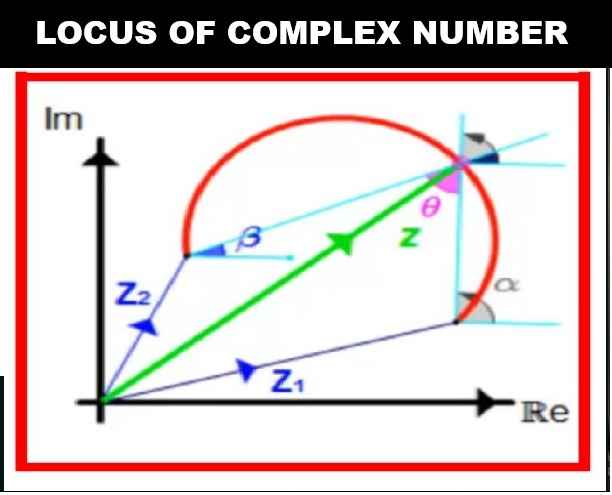Absorption by Root Class-10 Long and Structured Questions Goyal Brothers ICSE Biology Solutions Ch-4 . We Provide Solutions of long Answer Questions and Structured Questions of Exercise-4 Absorption by Root. All solutions are given as council prescribe guideline for next upcoming exam. Visit official Website CISCE for detail information about ICSE Board Class-10 Biology.
Ch-4 Absorption by Root Long and Structured Questions
(Goyal Brothers Prakashan ICSE Class-10 Biology Solutions)
| Board | ICSE |
| Publications | Goyal Brothers publications |
| Subject | Biology |
| Class | 10th |
| Writer | Dr. K.K. Aggrawal |
| Chapter-4 | Absorption by Root |
| Topics | Solutions of Long Answer Questions and Structured Questions |
| Edition | for 2022-2023 Academic Session |
D. LONG ANSWER QUESTIONS
Ch-4 Absorption by Root Goyal Brothers Prakashan ICSE Class-10 Biology Solutions
(Page-56)
Question 1. What is the significance of osmosis? Explain in brief.
Answer : It maintains the turgidity of cells. It is a process by which plants maintain their water content despite the constant water loss due to transpiration. This process controls the cell to cell diffusion of water. Osmosis induces cell turgor which regulates the movement of plants and plant parts.
Question 2. What is the utility of plasmolysis?
Answer : Plasmolysis helps in the preservation of meat and fish by salting. It is also helpful in the preservation of jellies and jams by adding concentrated sugar solution to them. It helps in plasmolysing the spores of bacteria and fungi.
Question 3. Explain two manifestations of root pressure.
Answer : 1) Humidity in relativeness and are inversely proportional to the transpirational rate. 2) Light presence and absence affects transpirational rate as, the stomata closes and opens likewise controlling the environmental variables too
Question 4. A marine fish is kept in freshwater :
(a) What would happen to the fish?
(b) Name the pressure that develops inside the cells of the fish.
Question 5. Name the pressure that regulates the drooping and recovery of the leaves.
Answer :
(a) If a marine fish is placed in freshwater, the surrounding water moves inside the body of the fish through endosmosis leading to the swelling of its cells and killing the fish. The fish are sensitive even to the smallest fluctuations in the salinity of water
(b) The pressure is osmotic pressure
E. STRUCTURED QUESTIONS
Ch-4 Absorption by Root Goyal Brothers Prakashan ICSE Class-10 Biology Solutions
(Page-57)
Question 1. The diagram given below represents a layer of epidermal cells showing a fully-grown root hair. Study the diagram and answer the questions that follow :

(i) Name the parts labelled A, B, C and D.
(ii) The root hair cell is in a turgid state Name and explain the process that caused this state.
(iii) Mention one distinct difference between the parts labelled A and B.
(iv) Draw a diagram of the above root hair cell as it would appear when a added near it.
Answer :
(i) A – Cell wall of root hair.
B – Cell membrane of root hair
C – Cytoplasm
D – Nucleus
(ii) The soil medium is hypotonic. So endosmosis occur due to which the root hair cell turns turgid.
(iii)
| A (Cell wall) | B (Cell membrane) |
| Is freely permeable | Is semi permeable |
(iv)
Question 2. Given below are diagram of plant cells as seen under the microscope after having been placed in two different solutions :
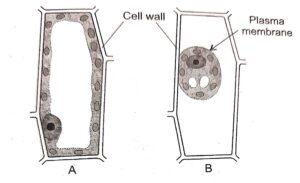
(i) What is the technical term for the condition of :
(a) Cell A (b) Cell B ?
(ii) Form the solutions given in brackets (Water, strong sugar solutions, 1% salt solution) name the solutions into which :
(a) Cell A (b) Cell B, was placed before being viewed under the microscope.
(iii) Under what conditions in the soil will the root hair cell resemble:
(a) Cell A (b) Cell B?
(iv) Name the pressure responsible for the movement of water from the root hair cell to the xylem of the root. How is it set up?
(v) Name the pressure that helps in the movement of water up the xylem of the root.
Answer :
(i) 1- Turgid cell 2- Plasmolysed cell
(ii) 1- Water 2- 1% salt solution
(iii) 1- The root hair cell will resemble cell A when the soil is well watered.
2- The root hair cell will resemble cell B when there is a high concentration of fertiliser in the soil and less water in it.
(iv) Root Pressure: Root pressure is responsible for the movement of water from the root hair cell to the xylem of the root. It is built up by endosmosis in the root hair cells and cell to cell osmosis in the cortex cells which push water into the xylem.
(v) Transpirational pull
Question 3. Given below is the diagram of an apparatus set-up to study a very important physiological process:
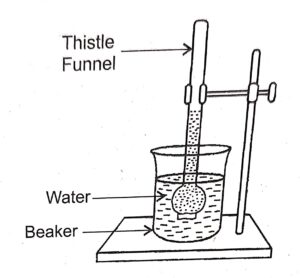
(i) Name the process being studied.
(ii) Explain the process.
(iii) What change would you observe in the thistle funnel containing sugar solution after about 10 minutes ?
(iv) Is sugar solution hypertonic or hypotonic ?
(v) Name the part of the plant cell which is represented by the sugar solution.
Answer :
(i) Osmosis.
(ii) The diffusion of water molecules through a semipermeable membrane from a dilute solution to concentrated solution.
(iii) After about 10 minutes the sugar solution in the thistle funnel rises up.
(iv) Hypotonic.
(v) Cell sap of the root hair.
Question 4. Given below is the diagram of a cell as seen under the microscope after having been placed in a solution:

(i) What is the technical term used for the state / condition of the cell given above ?
(ii) Give the technical term for the solution in which the ceil was placed.
(iii) Name, the parts numbered 1 to 4.
(iv) Is the cell given above a. plant cell or an animal cell ? Give two reasons in support of your answer as evident from the diagram.
(v) What would you do to bring this cell back to it original condition ?
Answer :
(i) Plasmolysed
(ii) Hypertonic solution
(iii) (1) Nucleus (2) Chloroplast (3) Vacuole (4) Hypertonic solution
(iv) Plant cell. Because
(1) Clear distinct cell wall is seen
(2) Chloroplast clearly seen in. the cytoplasm.
(3) Centrosome not seen.
(v) Place it on a hypotonic medium or plain water for some time.
Question 5. A candidate in order to study the process of osmosis has taken 3 potato cubes and put them in 3 different beakers containing 3 different solutions. After 24 hours, in the first beaker the potato cube increased in size, in the second beaker the potato cube decreased in size and in the third beaker there was no change in the size of the potato cube. The following diagram shows the result of the same experiment:
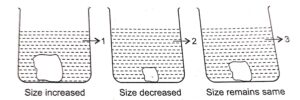
(i) Give the technical terms of the solutions used in beakers, 1, 2, and 3.
(ii) In beaker 3 the size of the potato cube remains the same. Explain the reason in brief.
(iii) Write the specific feature of the cell sap of root hairs which helps in absorption of water.
(iv) What is osmosis ?
(v) How does a cell wall and a cell membrane differ in their permeability ?
Answer :
(i) (1) Hypotonic solution.
(2) Hypertonic solution.
(3) Isotonic solution.
(ii) In beaker 3, the concentration of potato cube and the medium is same. So there is no osmosis taking place therefore the size of cube remains same.
(iii) The concentration of cell sap is higher in the root hair as compared to soil water due to endosmoses is takes place facilitating absorption of water.
(iv) Osmosis is a process of flow of solvent molecules from lower concentration to higher concentration through a semipermeable membrane.
(v) Cell wall is freely permeable and cell membrane is semi-permeable.
Question 6. The figure given below is a diagrammatic representation of a part of the cross section of the root in the root hair zone. Study the same and then answer the questions that follow :
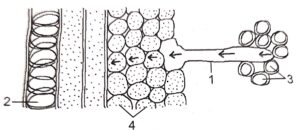
(i) Name the parts indicated by the guidelines 1 to 4.
(ii) Which is the process that enables the passageqf water from the soil into the root hair ?
(iii) Name the pressure that is responsible for the movement of water in the direction indicated by the arrows. Define it.
(iv) Due to an excess of this pressure sometimes drops of water are found along the leaf margins of some plants especially in the early mornings. What is the phenomenon called ?
(v) Draw a well labelled diagram of the root hair cell as it would appear if an excess of fertiliser is added to the soil close to it.
Answer :
(i) 1. Root hair 2. Soil water 3. Xylem Vessels 4. Cortical cells.
(ii) Osmosis Process
(iii) Osmotic pressure: The pressure exerted by a solution to prevent the entry of water molecules, through the semi -permeable membrane is called Osmotic pressure.
(iv) Guttation.
(v)
Question 7. The diagram given below represents a plant cell after being placed in a strong sugar solution.
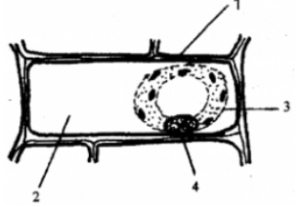
(i) What is the state of the cell shown in the diagram?
(ii) Name the structure that acts as a selectively permeable membrane.
(iii) Label the parts numbered 1 to 4 in the diagram.
(iv) How can the above cell be brought back to its original condition? Mention the scientific term for the recovery of the cell.
(v) State any two features of the above plant cell which is not present in animal cells.
Answer :
(i) The state of the cell is Plasmolysed.
(ii) Cell membrane.
(iii)
1.Cell wall
2. Strong sugar solution
3. Cell membrane
4. Nucleus.
(iv) By putting it in hypotonic solution/water.
The scientific term for the recovery of the cell is deplasmolysis.
(v) (i) Cell wall
(ii) Vacuole.
— : End of Absorption by Root Class-10 Goyal Brothers Prakashan Solutions :–
Return to :- ICSE Biology for Class 10 Goyal Brothers Prakashan solutions
Thanks


